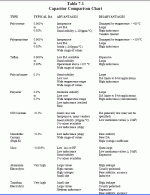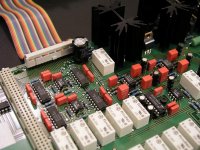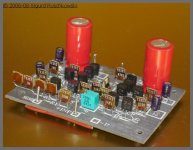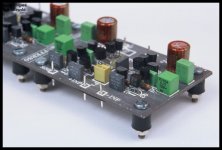I am sure you have a CD player, or a HiENd DAC with a CD transport.
Do you know how many X7R caps are in such a transport ?
What about caps within the ICs ? They are all polystyrene ?
Patrick
Do you know how many X7R caps are in such a transport ?
What about caps within the ICs ? They are all polystyrene ?
Patrick
syn08 said:
...
- For supply decoupling, ceramics (even the X7R) are good enough; foil caps are inferior due to larger ESL, potentially leading to parasitic resonances.
...
If I want a clean/low noise power supply, in a high vibration environment as audio is, I'll avoid as much as possible any Z5U or X7R cap.
Regards,
Tibi
EUVL said:I am sure you have a CD player, or a HiENd DAC with a CD transport.
Do you know how many X7R caps are in such a transport ?
What about caps within the ICs ? They are all polystyrene ?
Patrick
This is one of the main reasons that many audiophiles, (like us, I hope) are using soundcare spikes and vibration absorbers inside chassis.
Less vibration - less "singing" from your X7R's . 😀
Regards,
Tibi
Excellent summary Syn08! I think this is what was asked for.syn08 said:
You are amazing, John 🙂 Who in hell said it will use ceramics instead of polypropilene, polystyrene, etc...?
This is for the 4th time I'm repeating this, here are my rules of thumb:
- Silver mica has larger DA than NP0 and C0G. In the same 0-100pF range, in the signal path (frequency compensation), NP0 and C0G ceramics are superior from all perspectives, in particular high voltage models.
- In the 100pF to 10nF range in the signal path (RIAA, etc...), the best option seems to be polystyrene.
- 10nF and up in the uF range, in the signal path (RIAA, interstage coupling, etc...), polypropilene rules.
- For supply decoupling, ceramics (even the X7R) are good enough; foil caps are inferior due to larger ESL, potentially leading to parasitic resonances.
- Teflon caps do not bring any significant improvements in audio.
Values ranges can be, of course, subject to debates and are somehow arbitrary.
Regarding ceramics, I've taken some Kemet multilayer NP0's apart, and inside them are 0805 SMD chips with leads!
What's the advantage/disadvantege of using single vs multilayer ceramics?
GOD !!!!
i only needed to know if it was ok to place ceramics very close to a regulator or over a rectifier in a small power supply ....
there is so much theory now arround this posts that some of it i can hardly understand
i only needed to know if it was ok to place ceramics very close to a regulator or over a rectifier in a small power supply ....
there is so much theory now arround this posts that some of it i can hardly understand
There is an article of Walt Jung that comments on capacitors, on your site
http://www.waltjung.org/ADI_Books.html
Attached a table on comparison of dielectric different.
http://www.waltjung.org/ADI_Books.html
Attached a table on comparison of dielectric different.
Attachments
tvicol said:
If I want a clean/low noise power supply, in a high vibration environment as audio is, I'll avoid as much as possible any Z5U or X7R cap.
Thud.
You need to review the role and purpose of a power supply decoupling cap and evaluate what is the performance impact of, say, 0.2% variation/modulation due to vibrations/microphony.
Don't forget to include in your analysis the fact that the ceramic cap almost always goes in parallel with an electrolytic that has usually 3 order of magnitude higher value and DA.
But then perhaps you enjoy the sound of Zeus amps or SE MOSFET amps with zero feedback and zero PSRR.
tvicol said:
This is one of the main reasons that many audiophiles, (like us, I hope) are using soundcare spikes and vibration absorbers inside chassis. Less vibration - less "singing" from your X7R's .
Also always suspend your power cables on aged tek wooden blocks - that certainly helps eliminating the nasty vibration noise in the power cable AC impedance.
syn08 said:
Thud.
You need to review the role and purpose of a power supply decoupling cap and evaluate what is the performance impact of, say, 0.2% variation/modulation due to vibrations/microphony.
Don't forget to include in your analysis the fact that the ceramic cap almost always goes in parallel with an electrolytic that has usually 3 order of magnitude higher value and DA.
But then perhaps you enjoy the sound of Zeus amps or SE MOSFET amps with zero feedback and zero PSRR.
Also always suspend your power cables on aged tek wooden blocks - that certainly helps eliminating the nasty vibration noise in the power cable AC impedance.
Well syn08, it seems that we have different sound references. If these things don't make a difference for you, than you can stick with ceramics.
Regards,
Tibi
but I can see two ceramics in that bit of the pre-amp.dodo said:for some unknow reason some very well reputated producers of the hi-end audio equipment don't like to use small ceramic caps even for the decoupling
AVM preamp
I can also see nine electrolytics in that part of the pre-amp, that does not bode well.
also some very well educated EE, who supply audio kits for DIY -audio community prefer plastic film caps for decoupling
If you ask them why , you get the answer ".... we checked , and with film caps sounds better to our ears ......"
Erno Borbely - super buffer
If you ask them why , you get the answer ".... we checked , and with film caps sounds better to our ears ......"
Erno Borbely - super buffer
Attachments
Seems every time the discussion moves to a tacid understanding that NP0s are OK in certain applications, the generalists counterattack with "all ceramics are bad because they can't be good for every application, so they should be banned from all audio use" argument.
pooge said:Seems every time the discussion moves to a tacid understanding that NP0s are OK in certain applications, the generalists counterattack with "all ceramics are bad because they can't be good for every application, so they should be banned from all audio use" argument.
Yes, NP0's are OK for some applications, but not high-end audio. 😀
Regards,
Tibi
dodo said:for some unknow reason some very well reputated producers of the hi-end audio equipment don't like to use small ceramic caps even for the decoupling
AVM preamp
I'm not saying it is so, but chances are that washing over a piece of equipment with Wima caps, is just plain marketing.
At least it bears no proof to film caps being better than NP0.
Magura 🙂
tvicol said:
Yes, NP0's are OK for some applications, but not high-end audio. 😀
Regards,
Tibi
Would you care to specifically explain why this is not so? Is it for the reason you don't like to look up the code on the package?
possibly because the high end manufacturers do not want their reputations tarnished by being seen to use supposedly inferior components, irrespective of whether these "cheap" components may do a better job.pooge said:
Would you care to specifically explain why this is not so? Is it for the reason you don't like to look up the code on the package?
- Status
- Not open for further replies.
- Home
- Amplifiers
- Solid State
- ceramic capacitors ....




